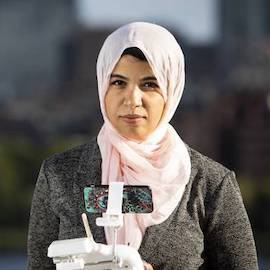Menu
ESI Stories
Three questions on cities and climate change with Norhan Bayomi
ESI’s newest member is Norhan Bayomi, a post-doctoral fellow who studies climate adaptation in urban environments, using emerging technologies like drones and AI to better map the effects of extreme heat in cities, with an eye toward urban design for heat resilience in the developing world. Norhan joins ESI from the MIT Building Technology Program, where she recently received her PhD, advised by ESI Director John Fernández. Here, she will join and expand our research programs in cities and climate change.
To introduce Norhan, we asked her three questions about climate impacts in cities.
 How much influence do cities have in developing effective climate solutions?
How much influence do cities have in developing effective climate solutions?
Cities are a key contributor to climate change solutions, as they can provide significant opportunities as places where high living standards can be achieved with much lower levels of emissions and resource use. Cities have also long been places of social, economic and political innovation, and we have seen many examples of city politicians demonstrating a greater commitment to greenhouse gas reduction and climate solutions than do national politicians.
What have you learned from studying climate preparedness in a variety of different cities around the world?
Through my research on extreme heat events impacts, especially at the urban level, I found that there is a dire need to prioritize areas of high vulnerability when looking into climate preparedness strategies. This kind of assessment is important for low-income and underrepresented populations who are lacking resources for adaptation, and is also essential to rapidly track and monitor health threats under extreme climate events. Because many of the threats associated with global warming are generally predictable, it is possible to design or adapt buildings and communities to be more resilient, but that will also require preparedness at the policy level and access to better data.
What can MIT and ESI do to help cities better prepare for a warming world?
MIT and ESI can advance climate change preparedness in cities through putting emphasis on urban communities. We need to pursue research to improve the understanding of the likely timing of impacts, the possible size of the impacts, and how to address uncertainty, including specific responses such as how to use novel technologies to assist with evacuation during a flood or to help an elderly relative during a heat wave.















